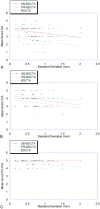Bone-subtraction CT angiography: evaluation of two different fully automated image-registration procedures for interscan motion compensation
- PMID: 17698541
- PMCID: PMC7977676
- DOI: 10.3174/ajnr.A0558
Bone-subtraction CT angiography: evaluation of two different fully automated image-registration procedures for interscan motion compensation
Abstract
Background and purpose: Bone-subtraction techniques have been shown to enhance CT angiography (CTA) interpretation, but motion can lead to incomplete bone removal. The aim of this study was to evaluate 2 novel registration techniques to compensate for patient motion.
Materials and methods: Fifty-four patients underwent bone-subtraction CTA (BSCTA) for the evaluation of the neck vessels with 64-section CT. We tested 3 different registration procedures: pure rigid registration (BSCTA), slab-based registration (SB-BSCTA), and a partially rigid registration (PR-BSCTA) approach. Subtraction quality for the assessment of different vascular segments was evaluated by 2 examiners in a blinded fashion. The Cohen kappa test was applied for interobserver variability, and the Wilcoxon signed rank test, for differences between the procedures. Motion between the corresponding datasets was measured and plotted against image-quality scores.
Results: Algorithms with motion compensation revealed higher image-quality scores (SB-BSCTA, mean 4.31; PR-BSCTA, mean 4.43) than pure rigid registration (BSCTA, mean 3.88). PR-BSCTA was rated superior to SB-BSCTA for the evaluation of the cervical internal and external carotid arteries (P<.001), whereas there was no significant difference for the other vessels (P=.157-.655). Both algorithms were clearly superior to pure rigid registration for all vessels except the basilar and ophthalmic artery. Interobserver agreement was high (kappa=0.46-0.98).
Conclusion: Bone-subtraction algorithms with motion compensation provided higher image-quality scores than pure rigid registration methods, especially in cases with complex motion. PR-BSCTA was rated superior to SB-BSCTA in the visualization of the internal and external carotid arteries.
Figures





Similar articles
-
Carotid computed tomography angiography with automated bone suppression: a comparative study between dual energy and bone subtraction techniques.Invest Radiol. 2009 Jun;44(6):322-8. doi: 10.1097/RLI.0b013e31819e8ad9. Invest Radiol. 2009. PMID: 19363448
-
Cervical CT angiography comparing routine noncontrast and a late venous scan as masks for automated bone subtraction: feasibility study and examination of the influence of patient motion on image quality.Invest Radiol. 2008 Jan;43(1):27-32. doi: 10.1097/RLI.0b013e31815597ac. Invest Radiol. 2008. PMID: 18097274
-
Cranial computed tomography angiography with automated bone subtraction: a feasibility study.Invest Radiol. 2009 Jan;44(1):38-43. doi: 10.1097/RLI.0b013e31818c3d6b. Invest Radiol. 2009. PMID: 18836384
-
Clinical evaluation of bone-subtraction CT angiography (BSCTA) in head and neck imaging.Eur Radiol. 2006 Apr;16(4):889-97. doi: 10.1007/s0330-005-0032-1. Epub 2005 Nov 3. Eur Radiol. 2006. PMID: 16267665
-
Image Registration in Longitudinal Bone Assessment Using Computed Tomography.Curr Osteoporos Rep. 2023 Aug;21(4):372-385. doi: 10.1007/s11914-023-00795-6. Epub 2023 Jun 2. Curr Osteoporos Rep. 2023. PMID: 37264231 Free PMC article. Review.
Cited by
-
Evaluation of Different Registration Algorithms to Reduce Motion Artifacts in CT-Thermography (CTT).Diagnostics (Basel). 2023 Jun 15;13(12):2076. doi: 10.3390/diagnostics13122076. Diagnostics (Basel). 2023. PMID: 37370971 Free PMC article.
-
Multi-detector row CT angiography with direct intra-arterial contrast injection for the evaluation of neurovascular disease: technique, applications, and initial experience.AJNR Am J Neuroradiol. 2009 May;30(5):1054-8. doi: 10.3174/ajnr.A1438. Epub 2009 Feb 12. AJNR Am J Neuroradiol. 2009. PMID: 19213819 Free PMC article.
-
Metallic Component Preserving Algorithm Based on the Cerebral Computed Tomography Angiography in Aneurysm Surgery.Diagnostics (Basel). 2022 Jan 28;12(2):338. doi: 10.3390/diagnostics12020338. Diagnostics (Basel). 2022. PMID: 35204429 Free PMC article.
-
128-slice acceletated-pitch dual energy CT angiography of the head and neck: comparison of different low contrast medium volumes.PLoS One. 2013 Nov 19;8(11):e80939. doi: 10.1371/journal.pone.0080939. eCollection 2013. PLoS One. 2013. PMID: 24260516 Free PMC article. Clinical Trial.
-
Virtual non-calcium dual-energy CT: clinical applications.Eur Radiol Exp. 2021 Sep 3;5(1):38. doi: 10.1186/s41747-021-00228-y. Eur Radiol Exp. 2021. PMID: 34476640 Free PMC article. Review.
References
-
- Achenbach S, Ropers D, Pohle FK, et al. Detection of coronary artery stenoses using multi-detector CT with 16 × 0.75 collimation and 375 ms rotation. Eur Heart J 2005;26:1978–86. Epub 2005 May 27 - PubMed
-
- Coxson HO, Baile EM, King GG, et al. Diagnosis of subsegmental pulmonary emboli: a multi-center study using a porcine model. J Thorac Imaging 2005;20:24–31 - PubMed
-
- Ghersin E, Litmanovich D, Dragu R, et al. 16-MDCT coronary angiography versus invasive coronary angiography in acute chest pain syndrome: a blinded prospective study. AJR Am J Roentgenol 2006;186:177–84 - PubMed
-
- Kanne JP, Lalani TA. Role of computed tomography and magnetic resonance imaging for deep venous thrombosis and pulmonary embolism. Circulation 2004;10(12 suppl 1):I15–21 - PubMed
Publication types
MeSH terms
LinkOut - more resources
Full Text Sources
Medical
Research Materials
